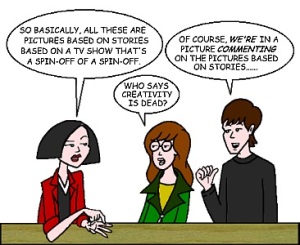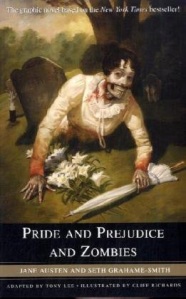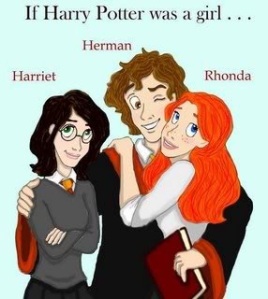
Darcy Moore’s (2012), abstract concept of “Social Reading“, outlines the evolution of the concept of traditional reading into an online collective discussion. Once a sacred personal connection between author and reader, social reading has revolutionised individual response to a collective conglomeration of thoughts, experiences and other points of view. Black (2009), refers to this as a collective imagination. A multilayered discussion fuelled by a variety of mind frames. These critique networks can provide the reader with a depth of understanding. Gaiman (2013), suggests the collective discussion of narrative is essential in building the foundations of reading and communication in our online world. He suggests, the rapid increase in popularity is due to the ease of access and the incentive of anonymity for the laptop critic.
Social reading has encouraged the rise of a new collective voice – Fan Fiction. Downes (2014), defines Fan Fiction or FanFic as any work that rewrites, elaborates on or creates alternative plots and characters from another author. The content extends on known literature or pop culture. So what of the copyright on intellectual property?
I was aware of FanFic but I was completely flawed by its popularity. To put it into perspective, according to Wikipedia (2015) list of best sellers, Harry Potter (books) to date has sold approximately 400 million copies – give or take a few. Yet in just one FanFiction site alone there are over 85,000 spin-off stories and over 2.1 million reads.
http://www.harrypotterfanfiction.com
Titles such as Pride and Prejudice and Zombies (Austen, J. and Graham-Smith, S.) and 50 Shades of Grey (E.L.James, 2011) found their genesis in FanFic and have proven to be very marketable commodities. James (2013), attributed the 50 shades trilogy as being inspired byTwilight, and was originally a FanFic story.

Downes (2014), describes Fan Fiction sites as being an ‘internet sensation’. With members being numbered in the hundreds of millions. He highlights, however; some legitimate concerns for young people. These include exposure to uncensored sexualisation through ePublications, pornographic content, and idolisation or romanising of mental illness and violence. So, a personal investigation ensued. It was a truly eye-opening experience. The number of forums are staggering. The more reputable ones have warnings and tags. Tags allow the writer to categorise their work. Some of these tags include,
FLUFF – sappy romantic themes involved.
SMUT – containing sexual content.
AU – the settings are in an alternative universe
POV – multiple points of view.
A benefit of mandatory categorisation means the writer is analysing their work (sound familiar teachers of English). Ergo, proofreading is an expectation before publication. A necessary skill indeed. Writers must also warn readers of sensitive issues or themes in their story. This is again done through tags. For example, if your work contained explicit language, rape, suicide, anxiety or depression it must include a tag to inform the reader. Whilst there is a huge amount of extreme Fan Fiction out there and some fairly sordid ideas, the concept is encouraging a generation to explore creative writing.
So I wanted to experience it for myself and wrote my first ever published work. I was surprised by how I felt. Mostly about what to write, being authentic to the original and how it would be judged. However, I survived my first publication and enjoyed it.
http://www.wattpad.com/myworks/50359425-marlenes-journey-back
There is no denying, like anything online, there are dark, compromised and unsafe places, however; I love what Gaiman (2013), said, “We have an obligation to imagine.”
References
Austen, J., Graham-Smith, S. (2010). Pride and Prejudice and Zombies. Quirk Books. Philadelphia, USA
Black, R.W. (2008). Adolescents and online fan fiction. New York: Peter Lang.
Black, R.W. (2009). Online Fan Fiction, Global Identities, and Imagination
Research in the Teaching of English, Vol. 43, No. 4 (May 2009), pp. 397-425. National Council of Teachers of English. http://www.jstor.org/stable/27784341 23-09-2015 12:08 UTC.
Gaiman, N. (2013). Why our Future Depends on Libraries, Reading and Daydreaming. (A Lecture) In Cooper, S. (2013). Libraries are the frontline in the war for imagination. http://www.theguardian.com/books/2013/oct/15/neil-gaiman-future-libraries-reading-daydreaming accessed 23/09/2015 at 11.42pm.
Downes, S. (2014). Column: What is Fan Fiction – and why is it making people nervous?. thejournal.ie 01/03/2014. [online] accessed 21/09/2015. http://www.thejournal.ie/readme/what-is-fan-fiction-and-why-is-it-making-people-nervous
James, E.L. (2013). Biography. [online] http://www.biography.com/people/el-james-21129925. Accessed 22/09/2015 at 11.04pm.
Moore, D. (2012). Social Reading: Fad or Future. Darcy Moore Blog. http://www.darcymoore.net/2012/07/29/social-reading-fad-or-future. [online] accessed 21/09/2015 at 5.45pm.
Potter, C. (2009). Harry Potter and The Temple of Witchcraft. [online]. http://www.harmony.fanfiction.tumblr.com accessed 22/09/2015, at 5:15pm.
Wikipedia. (2015). List of best-selling books. https://en.wikipedia.org/wiki/List_of_best-selling_books [online] accessed 23/09/2015 5.45pm.

Leave a comment